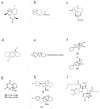Biological actions of artemisinin: insights from medicinal chemistry studies
- PMID: 20335987
- PMCID: PMC6257283
- DOI: 10.3390/molecules15031378
Biological actions of artemisinin: insights from medicinal chemistry studies
Abstract
Artemisinins have become essential antimalarial drugs for increasingly widespread drug-resistant malaria strains. Although tremendous efforts have been devoted to decipher how this class of molecules works, their exact antimalarial mechanism is still an enigma. Several hypotheses have been proposed to explain their actions, including alkylation of heme by carbon-centered free radicals, interference with proteins such as the sarcoplasmic/endoplasmic calcium ATPase (SERCA), as well as damaging of normal mitochondrial functions. Besides artemisinins, other endoperoxides with various backbones have also been synthesized, some of which showed comparable or even higher antimalarial effects. It is noteworthy that among these artemisinin derivatives, some enantiomers displayed similar in vitro malaria killing efficacy. In this article, the proposed mechanisms of action of artemisinins are reviewed in light of medicinal chemistry findings characterized by efficacy-structure studies, with the hope of gaining more insight into how these potent drugs work.
Figures


Similar articles
-
Considerations on the mechanism of action of artemisinin antimalarials: part 1--the 'carbon radical' and 'heme' hypotheses.Infect Disord Drug Targets. 2013 Aug;13(4):217-77. doi: 10.2174/1871526513666131129155708. Infect Disord Drug Targets. 2013. PMID: 24304352 Review.
-
Heme as trigger and target for trioxane-containing antimalarial drugs.Acc Chem Res. 2010 Nov 16;43(11):1444-51. doi: 10.1021/ar100070k. Epub 2010 Aug 30. Acc Chem Res. 2010. PMID: 20804120 Review.
-
Combating multi-drug resistant malaria parasite by inhibiting falcipain-2 and heme-polymerization: Artemisinin-peptidyl vinyl phosphonate hybrid molecules as new antimalarials.Eur J Med Chem. 2021 Aug 5;220:113454. doi: 10.1016/j.ejmech.2021.113454. Epub 2021 Apr 14. Eur J Med Chem. 2021. PMID: 33901900
-
Re-evaluation of how artemisinins work in light of emerging evidence of in vitro resistance.Trends Mol Med. 2006 May;12(5):200-5. doi: 10.1016/j.molmed.2006.03.005. Epub 2006 Apr 17. Trends Mol Med. 2006. PMID: 16616639 Free PMC article.
-
Enantiomeric 1,2,4-trioxanes display equivalent in vitro antimalarial activity versus Plasmodium falciparum malaria parasites: implications for the molecular mechanism of action of the artemisinins.Chembiochem. 2005 Nov;6(11):2048-54. doi: 10.1002/cbic.200500048. Chembiochem. 2005. PMID: 16222725
Cited by
-
Rearrangements of organic peroxides and related processes.Beilstein J Org Chem. 2016 Aug 3;12:1647-748. doi: 10.3762/bjoc.12.162. eCollection 2016. Beilstein J Org Chem. 2016. PMID: 27559418 Free PMC article. Review.
-
Advances in the research on the targets of anti-malaria actions of artemisinin.Pharmacol Ther. 2020 Dec;216:107697. doi: 10.1016/j.pharmthera.2020.107697. Epub 2020 Oct 6. Pharmacol Ther. 2020. PMID: 33035577 Free PMC article. Review.
-
Plasmodium yoelii iron transporter PyDMT1 interacts with host ferritin and is required in full activity for malarial pathogenesis.BMC Biol. 2023 Dec 5;21(1):279. doi: 10.1186/s12915-023-01776-y. BMC Biol. 2023. PMID: 38049852 Free PMC article.
-
Purine and pyrimidine pathways as targets in Plasmodium falciparum.Curr Top Med Chem. 2011;11(16):2103-15. doi: 10.2174/156802611796575948. Curr Top Med Chem. 2011. PMID: 21619511 Free PMC article. Review.
-
A single nucleotide polymorphism in the Plasmodium falciparum atg18 gene associates with artemisinin resistance and confers enhanced parasite survival under nutrient deprivation.Malar J. 2018 Oct 26;17(1):391. doi: 10.1186/s12936-018-2532-x. Malar J. 2018. PMID: 30367653 Free PMC article.
References
-
- Utzinger J., Xiao S.H., Tanner M., Keiser J. Artemisinins for schistosomiasis and beyond. Curr. Opin. Investig. Drugs. 2007;8:105–116. - PubMed
Publication types
MeSH terms
Substances
LinkOut - more resources
Full Text Sources
Miscellaneous

